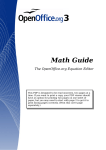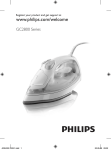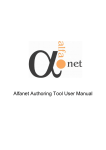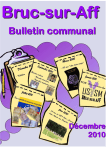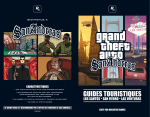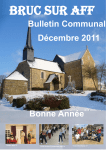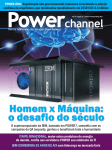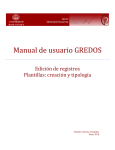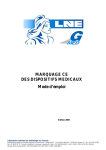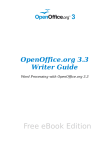Download METADATA ELEMENT SET: USER GUIDE
Transcript
METADATA ELEMENT SET: USER GUIDE (draft - 01-04-2001) Metadata Element Set User Guide 01-04-2001 Most current version: Previous Version(s): Author: Status of this document: http://reti.unimc.it/userguide.htm http://reti.unimc.it/userguide3.htm http://reti.unimc.it/userguide2.htm http://reti.unimc.it/userguide1.htm Giovanni Michetti This is a working draft for review by research members and technical staff. Publication as working draft does not imply endorsement by the researchers community. This is a draft document and may be updated, replaced or made obsolete by future developments. Table of Contents TABLE OF CONTENTS 1. Purpose and scope 2. Concept of metadata 3. Dublin Core 4. The 1-to-1 Principle 5. Element set 6. Complete examples 7. References Metadata Element Set User Guide (draft - 1-04-2001) 2 Purpose and Scope PURPOSE AND SCOPE This document is intended to help researchers create simple descriptive records for informative system of Networking Women project. The guide shows in a non-technical fashion the basic principles and references used to define our metadata structure. The body of the guide provides an interpretation of each element's definition, along with brief discussions of issues associated with each element and useful examples of resources descriptions. A large section of complete examples is intended to present models of resource description, referring to which searchers may implement their own informative records. Another important goal of this document is to promote best practices for describing resources using the proposed element set: the consistency in creating metadata is an important key to achieving complete retrieval and intelligible display across disparate sources of descriptive records. Inconsistent metadata effectively hides desired records, resulting in uneven, unpredictable or incomplete search results. From a practical point of view, the purpose of our work is to have a document that may be used as a standalone product on the cataloguer's desktop, representing both the model used to describe a knowledge domain and the application cases used to direct searchers choices. The guide has been written referring to and using documents of DCMI (Dublin Core Metadata Initiative), CIMI (Consortium for the Computer Interchange of Museum Information), AHDS (Arts and Humanities Data Service). The present work has been written adopting User Guide Working Draft of DCMI as a template and conforming to it whenever possible in order to limit changes to Dublin Core model: see References chapter for more detailed information. Metadata Element Set User Guide (draft - 1-04-2001) 3 Concept of Metadata CONCEPT OF METADATA There are a lot of definitions for metadata, each one trying to describe and restrict metadata's nature to a single aspect, each one with a different meaning's nuance: • machine-understandable data about web resources, or other objects • data providing information about a resource • information that characterizes data • data that describes a resource • data that can be used by searchers to identify features shared by different documents. The simplest and most effective definition is probably the shorter one, whose vagueness may be enriched by more precise contents, according to highlighted aspect. We call metadata simply data about data, that is data describing other data. This very general definition includes an almost limitless spectrum of possibilities ranging from human-generated textual description of a resource to machine-generated data that may be useful only to software applications. Effectively, without loss of generality, we could refine this definition and say metadata structured data about data: anyway emerging feature is communicating information about information. The term metadata has been used only in the past fifteen years, and has become particularly common with the popularity of the world wide web. But the underlying concepts have been in use for as long as collections of information have been organized. Library catalogues represent a well established variety of metadata that has served for decades as collection management and resource discovery tools. Although the concept of metadata predates the Internet and the web, worldwide interest in metadata standards and practices has exploded with the increase in electronic publishing and digital libraries, and the concomitant information overload resulting from vast quantities of undifferentiated digital data available online. Anyone who has attempted to find information online using one of today's popular web search service has likely experienced the frustration of retrieving hundreds, if not thousands, of hits with limited ability to refine or make a more precise search. Current web indexing evolved rapidly to fill the demand for resource discovery tools, but that indexing, while useful, is a poor substitute for richer varieties of resource description. Metadata may be applied to every medium, but digital communication processes have pointed out their special need for metadata. It is clear yet that, in an indefinitely wide resource's space, effective network information management relies on effective metadata management. Metadata supply different functions related to three different resource managing area: • access • managing • analysis Resources may indeed be searched, managed and analysed without metadata. But metadata are a key to coherently and effectively develop control over resources and give more meaning to searching, managing and analysing. They support a lot of typical activities of an informative structure: • synthesis: to summarize data meaning, their scope; • search: to allow information search; • advice: to help users to know whether resources are interesting for them; • selection: to help and decide which data instance retrieve; • data administration: to give information about objects management in a server or a repository Metadata Element Set User Guide (draft - 1-04-2001) 4 Concept of Metadata • data links: to give details about relations between objects; and so on. Such activities may be supported by a digital document through metadata describing: • information about author, editor, publisher; • information about copyright; • information about classification system, if any; • information about content or relation between components. From a practical point of view, a metadata record consists of a set of attributes, or elements, necessary to describe the resource in question. For example, a matadata system common in libraries, the library catalogue, contains a set of metadata records with elements that describe a book or other library item: author, title, date of creation or publication, subject coverage, and the call number specifying location of the item on the shelf. The linkage between a metadata record and the resource it describes may take one of two forms: 1. elements may be contained in a record separate from the item, as in the case of the library's catalogue record; 2. metadata may be embedded in the resource itself. Examples of embedded metadata that is carried along with the resource itself include the Catalogue In Publication (CIP) data printed on the verso of a book's title page; or ISBN code printed on the book itself. Metadata Element Set User Guide (draft - 1-04-2001) 5 Dublin Core DUBLIN CORE Dublin Core (DC) metadata is specifically intended to support resource discovery. The elements represent a broad, interdisciplinary consensus about the core set of elements that are likely to be widely useful to support resource discovery. DC metadata standard is a simple but effective element set for describing a wide range of networked resources. The DC standard comprises fifteen elements, the semantics of which have been established through consensus by an international, cross-disciplinary group of professionals from librarianship, computer science, text encoding, the museum community, and other related fields of scholarship. Each element is optional and may be repeated. Each element also has a limited set of qualifiers attributes that may be used to further refine, not extend, the meaning of the element. Qualifiers allow applications to increase the specificity or precision of the metadata, but also introduces complexity that can impair interoperability. Thus, designers of metadata systems are well advised to be conservative about deploying qualifiers in cases where interoperability is one of the design objectives. Metadata elements may appear in any order. Although Dublin Core favors document-like objects (because traditional resources are fairly well understood), it can apply to other resources as well. Several of the fifteen DC elements record relationships between the resource-of-interest and another resource which is in-scope for DC. In particular, Relation and Source are used to indicate a connection with another resource of any type. Creator, Contributor and Publisher relate the present resource to a party who has some responsibility for it. Coverage relates the present resource to a place or a time-period. The Value recorded for each of these elements, therefore, should normally be strictly an identifier of another resource, which could, in principle, have its own description. In this way, it is possible that a web of DC descriptions of resources will be constructed, with each resource at the centre of a fan of descriptive arcs, but connected via one of these relationships to other resources with their own fans. Of course, the identifiers will, in many cases, use an informal notation in plain-text. DC metadata elements fall into three groups which roughly indicate the class or scope of information stored in them: 1. elements related mainly to the content of the resource 2. elements related mainly to the resource when viewed as Intellectual Property 3. elements related mainly to the Instantiation of the resource. Content Title Subject Description Type Source Relation Coverage Intellectual Property Creator Publisher Contributor Rights Metadata Element Set User Guide (draft - 1-04-2001) Instantiation Date Format Identifier Language 6 Dublin Core The 1-to-1 principle One proposal, currently under discussion by the larger DC community, states that one metadata record is created for each resource, that is a discrete resource should have a discrete metadata record. This is referred to as the 1-to-1 principle. It was proposed as a means to give enormous flexibility and power in describing information resources. This seems simple enough but it isn't always so neat because resources are often not so discreet. Should each photograph in an article have its own record? What about collections of articles? Can the collection be thought of as a resource? What about multimedia objects? What do we do about describing originals and their so-called surrogates? The original/surrogate problem is particularly important whenever each work, a sculpture for example, and surrogates of them like photographs and digital images of the photographs need to be described accurately but at the same time efficiently and usefully: surrogates of resources must be described separately from the original object. Let's take for example a famous painting, Mona Lisa. A metadata record for this item should have Leonardo daVinci as Creator and Mona Lisa, or La Gioconda as Title. For a photographic transparency of the sculpture, a second metadata record should have different values: Transparency of Mona Lisa could be the Title, or even Mona Lisa again; but Rossi, Mario is now the Creator of the transparency. A similar change of metadata occurs for a jpeg image of the transparency of the painting. The 1-to-1 rule can create problems both for creators of metadata and searchers. If one was creating a record for the transparency of the painting, the inclination might be to use the value Leonardo da Vinci as Creator since that information might be deemed to be of far greater utility for retrieval than the unknown photographer. It also make life much more simple to create a single record rather than two linked together via Relation element values. Some in the DC community now believe that the 1-to-1 principle should be revisited, and there is a working group that will address these issues and recommend guidelines that will promote consistent application. However, as of this writing, a good number of institutions and organizations strongly believes in 1-to-1 principle, and so do we. Metadata Element Set User Guide (draft - 1-04-2001) 7 Element set ELEMENT SET The element set adopted by Networking Women research community has been created adopting DC metadata element set as a model and making changes in order to achieve the best conformance to researchers needs, so losing in interoperability and adherence to standard, but improving precision of informative system via a custom-made descriptive structure. Given a fundamental understanding of the role of metadata in the discovery and management of networked information we can identify several challenges in describing cultural resources with not many elements: • the need to describe attributes of the physical object • the desire to associate the physical object with persons, places, and events • the need to account for collections • the need to account for surrogates such as photographs • a historical lack of content standards. The proposed model provides direction on representing cultural heritage resources as currently expected to be analysed by research community, not the entire universe of all possible associated information resources. The model comprises sixteen elements: elements 1 to 12 are based upon analogue elements of Dublin Core. Elements 13 to 16 are designed specifically for Networking Women research group. The present guide is not intended to discuss differences between our structure and DC model: see References chapter for more detailed information about this topic The present chapter is indeed the core of this user guide: here is provided information about features and semantics of each element adopted for describing resources by Networking Women researchers. Each element is described using the same formalism: • Element Name • Element Type: it is explained whether the element is - mandatory or not (that is, cataloguers must give or not a value for the element) - repeatable (that is, cataloguers may give more than one value) - free/discrete choice (that is, cataloguers may put any value or one of a predefined set) • Element Qualifiers: it is explained whether there are or not qualifiers, a sort of subfields of the element, to refine the meaning of the element. For each qualifier is given information about the type • Element Definition: a formal definition of the element • Element Comment: an explanation about semantics, problems and use of the element • Element Examples: practical examples of descriptive records. Examples are made increasingly throughout the guide: a descriptive record grows along with the element's number growth. In contrast to the convention of beginning with Title element, but according to CIMI recommendation, we begin with Type element because knowing what you are describing helps clarify the values of other elements. Use squared brackets whether to express uncertainty about any values assigned to elements (e.g. [1978] in case of doubt about creation date, or [Rossi, Mario] for a not clearly identified author) or to show that assigned values are deduced and not original (e.g. [Aerial view of Rome] for a Metadata Element Set User Guide (draft - 1-04-2001) 8 Element set postcard; [Essay about Women and Freedom] or [Women and Freedom: essay] or simply [Women and Freedom] for an untitled essay). Below is given the complete list of all the elements defining a descriptive record: 1. TYPE 2. FORMAT 3. IDENTIFIER 4. TITLE 5. AGENTS 6. DATE 7. LANGUAGE 8. RIGHTS 9. RELATION 10. COVERAGE 11. DESCRIPTION 12. SUBJECT 13. AVAILABILITY 14. VALUE 15. FUND 16. COMMENT 17. MARKS Metadata Element Set User Guide (draft - 1-04-2001) 9 Element set: TYPE 1. TYPE Type Occurrence: Choice: Mandatory Repeatable Discrete Qualifiers None Definition The nature or genre of the content of the resource. Comment The general form of the resource, such as text, image, sound, etc. For the sake of interoperability, Type must be selected from an enumerated list. To describe the physical or digital manifestation of the resource or where greater precision is required, use the Format element: for example, Type="Text", Format="Book". If the resource has content of multiple mixed types then repeated Type elements should be used to describe the main components. The list from which select the proper value is: • Text A resource whose content is primarily words for reading: for example, books, letters, dissertations, poems, newspapers, articles. Note that images of text are still of the genre text. • Image The content is primarily symbolic visual representation other than text: for example, images and photographs of physical objects, paintings, prints, drawings, animations and moving pictures, films, diagrams, maps. Note that Image may include both electronic and physical representations. • Sound A resource whose content is primarily audio or intended to be realized in audio: for example, music, speech, recorded sounds. This category includes musical notation, including score, which is unrealized sound. • Dataset Structured information encoded in lists, tables, databases, etc., which will normally be in a format available for direct machine processing: for example, spreadsheets, databases, GIS data, midi data. Note that unstructured numbers and words will normally be considered to be type Text. • Physical object A non-human object or substance: for example, a computer, a pyramid, a sculpture. Note that digital representations of, or surrogates for, these things should use Image, Text or one of the other types. Metadata Element Set User Guide (draft - 1-04-2001) 10 Element set: TYPE • Event A non persistent, time-based occurrence. Metadata for an event provide descriptive information that is basis for discovery of the purpose, location, duration and links to related events and resources. Examples: exhibition, web-cast, conference, workshop, open-day, performance, battle, trial, wedding, tea-party, conflagration. • Collection An aggregation of items. The term collection means that the resource is described as a group, its parts may be separately described and navigated. • Party A person, organization, cultural group, or institution. • Place A physical area. Examples • For a book: Type="Text" • For a photograph: Type="Image" • For a painting: Type="Image" Type="Physical object" • For a digital image: Type="Image" • For a long-playing: Type="Sound" • For a music CD: Type="Sound" • For a bronze: Type="Physical object" • For a live theatre performance: Type="Event" • For an archival fund: Type="Collection" • For an individual: Type="Party.Person" • For an organization: Metadata Element Set User Guide (draft - 1-04-2001) 11 Element set: TYPE Type="Party.Organization" • For a mountain: Type="Place" Metadata Element Set User Guide (draft - 1-04-2001) 12 Element set: FORMAT 2. FORMAT Type Occurrence: Choice: Optional Not Repeatable Discrete (for Medium), Free (for Extent) Qualifiers Medium: Extent: Optional, Not Repeatable, Discrete Choice Optional, Not Repeatable, Free Choice Definition The physical or digital manifestation/representation of the resource. Comment Typically, Format may include the media type or dimensions of the resource: the media type Format may be used to determine the software, hardware, or other equipment needed to display or operate the resource, while information concerning size and duration of the resource are examples of dimensions. Format might be used in resource discovery as a criterion to select resources of interest, since a user may need to evaluate whether they can make use of the resource within the infrastructure available to them. The element Format has two qualifiers: Medium and Extent. Medium is used to describe the data format of the resource. Extent is used to record details such as file size, page length, film playing times, the shelf occupied by an archive (in metres), etc. Put measurement units just after numeric values (e.g. 4 pp., 3 mt., 75 Kb, 1 h. 3 m.). Use English notation for numeric values (i.e. comma instead of point, and vice versa). For the sake of interoperability, the proper value for Medium must be selected from an enumerated list: • • • • • • • • • • • • • • • • Book Serial Letter Essay Article Citation List Photograph Slide Poster Transparency Drawing Xerox copy Video tape Film Digital audio CD Metadata Element Set User Guide (draft - 1-04-2001) 13 Element set: FORMAT • • • • • • • Audio tape Vinyl record Building Painting Sculpture Performance Digital file: ♦ rtf ♦ doc ♦ htm ♦ pdf ♦ bmp ♦ tif ♦ gif ♦ jpg ♦ aux ♦ wav ♦ mpg ♦ qts ♦ xls ♦ mdb ♦ ppt ♦ exe ♦ oth As shown above, Digital file value must be refined by the proper value of a controlled list of extension types: rtf for RTF files doc for Microsoft Word files htm for HTML files pdf for Adobe PDF files bmp for image files tif for image files gif for image files jpg for image files aux for audio files wav for audio files mpg for MPEG files qts for Quicktime files xls for Microsoft Excel files mdb for Microsoft Access files ppt for Microsoft Power Point files exe for executable files oth for other types of file Examples • For a book: Type="Text" Format.Medium="Book" Metadata Element Set User Guide (draft - 1-04-2001) 14 Element set: FORMAT Format.Extent="531 pp." • For a photograph: Type="Image" Format.Medium="Photograph" Format.Extent="18x12 cm." • For a copy of a photograph: Type="Image" Format.Medium="Xerox copy" Format.Extent="18x12 cm." • For a painting: Type="Image" Type="Physical object" Format.Medium="Painting" Format.Extent="77x53 cm." • For a digital image: Type="Image" Format.Medium="Digital file.gif" Format.Extent="4 Kb" (Title="[University of Rome Icon]") • For a digital image: Type="Image" Format.Medium="Digital file.jpg" Format.Extent="640x512 pixels" (Title="[Saturn image]") • For a long-playing: Type="Sound" Format.Medium="Vinyl record" Format.Extent="40 m. 27 s." • For a music CD: Type="Sound" Format.Medium="Digital audio CD" Format.Extent="52 m. 18 s." • For a bronze: Type="Physical object" Format.Medium="Sculpture" Format.Extent="13 cm." • For an unidentified object: Type="Physical object" Format.Extent="87 cm." • For a live theatre performance: Type="Event" Metadata Element Set User Guide (draft - 1-04-2001) 15 Element set: FORMAT Format.Medium="Performance" Format.Extent="1 h. 50 m." • For an archival fund: Type="Collection" Format.Extent="5.3 mt." • For a mountain: Type="Place" Format.Extent="2917 mt. (height)" Metadata Element Set User Guide (draft - 1-04-2001) 16 Element set: IDENTIFIER 3. IDENTIFIER Type Occurrence: Choice: Optional Not Repeatable Free Qualifiers None Definition An unambiguous reference to the resource within a given context. Comment Recommended best practice is to identify the resource by means of a string or number conforming to a formal identification system. Formal identification systems include the International Standard Book Number (ISBN), the International Standard Serials Number (ISSN), the Uniform Resource Locator (URL): Examples • For a book: Type="Text" Format.Medium="Book" Format.Extent="531 pp." Identifier="ISBN 1-56592-235-2" • For a networked resource: Type="Text" Format.Medium="Digital file.htm" Format.Extent="3 Kb" Identifier="http.//www.uniroma1.it/ssab" • For a painting: Type="Image" Type="Physical object" Format.Medium="Painting" Format.Extent="77x53 cm." Identifier="Louvre INV 779" • For a music CD: Type="Sound" Format.Medium="Digital audio CD" Format.Extent="45 m. 10 s." Identifier="CBS 460603-2" Metadata Element Set User Guide (draft - 1-04-2001) 17 Element set: IDENTIFIER • For an archival fund: Type="Collection" Format.Extent="5.3 mt." Identifier="F 032-1/a" • For a digital image: Type="Image" Format.Medium="Digital file.gif" Format.Extent="4 Kb" Identifier="http://www.uniroma1.it/ssab/logosap1.gif" (Title="[University of Rome Icon]") • For a digital image: Type="Image" Format.Medium="Digital file.jpg" Format.Extent="640x512 pixels" Identifier="C:|Documents|Research|Images|pict1.jpg" (Title="[Saturn image]") Metadata Element Set User Guide (draft - 1-04-2001) 18 Element set: TITLE 4. TITLE Type Occurrence: Choice: Mandatory Not Repeatable Free Qualifiers Alternative: Optional, Repeatable, Free Choice Definition A name given to the resource. Comment Typically, a Title will be a name by which the resource is formally known. If in doubt about what constitutes the title, use the Alternative qualifier to define all possible variants of the title. Title does not have to be unique. For untitled works of fine art, use whatever value you would use on the wall label copy, exhibition catalogue, or other promotional material (i.e. if the work is known as «Untitled» specify this in Title). For cultural items and collections with no known title or name, use a term or phrase that is sufficiently descriptive to permit a user to judge relevancy. Examples • For a book: Type="Text" Format.Medium="Book" Format.Extent="531 pp." Identifier="ISBN 1-56592-235-2" Title="HTML. The Definitive Guide" • For a networked resource: Type="Text" Format.Medium="Digital file.htm" Format.Extent="3 Kb" Identifier="http.//www.uniroma1.it/ssab" Title="SSAB Home Page" • For a photograph: Type="Image" Format.Medium="Photograph" Format.Extent="18x12 cm." Title="[Aerial view of Rome]" Metadata Element Set User Guide (draft - 1-04-2001) 19 Element set: TITLE • For a digital image: Type="Image" Format.Medium="Digital file.gif" Format.Extent="4 Kb" Identifier="http://www.uniroma1.it/ssab/logosap1.gif" Title="[University of Rome Icon]" • For a digital image: Type="Image" Format.Medium="Digital file.jpg" Format.Extent="640x512 pixels" Identifier="C:|Documents|Research|Images|pict1.jpg" Title="[Saturn image]" • For a painting: Type="Image" Type="Physical object" Format.Medium="Painting" Format.Extent="77x53 cm." Identifier="Louvre INV 779" Title="Monna Lisa" Title.Alternative="La Gioconda" • For a long-playing: Type="Sound" Format.Medium="Vinyl record" Format.Extent="40 m. 27 s." Title="Magical Mistery Tour" • For a music CD: Type="Sound" Format.Medium="Digital audio CD" Format.Extent="52 m. 18 s." Identifier="CBS 460603-2" Title="Kind of Blue" • For a networked resource: Type="Text" Format.Medium="Digital file.htm" Format.Extent="3 Kb" Identifier="http.//www.uniroma1.it/ssab" Title="SSAB Home Page" • For a bronze: Type="Physical object" Format.Medium="Sculpture" Format.Extent="13 cm." Title="Untitled" • For an unidentified object: Type="Physical object" Metadata Element Set User Guide (draft - 1-04-2001) 20 Element set: TITLE Format.Medium="Performance" Format.Extent="87 cm." Title="[Broken wooden pole (possible tool)]" • For a live theatre performance: Type="Event" Format.Medium="Performance" Format.Extent="1 h. 50 m." Title="Macbeth" Title.Alternative="The Scottish Play" • For an archival fund: Type="Collection" Format.Extent="5.3 mt.." Identifier="F 032-1/a" Title="Mario Rossi Papers" • For a mountain: Type="Place" Format.Extent="2917 mt. (height)" Title="Olympus Mount" Metadata Element Set User Guide (draft - 1-04-2001) 21 Element set: AGENTS 5. AGENTS Type Occurrence: Choice: Mandatory Repeatable Discrete (for Role), Free (for Name) Qualifiers Role: Name: Mandatory, Not Repeatable, Discrete Choice Mandatory, Not Repeatable, Free Choice Definition The entities responsible for making the content of the resource, making the resource available, or making contributions to the content of the resource. For example, authors or illustrators in the case of written documents, artists, actors, or directors in the case of visual resources. Comment Dublin Core Metadata Element Set provides two different elements pertaining to creation of the resource, Creator and Contributor (and one more element, Publisher, for its availability), defining the former as "an entity primarily responsible for making the content" and the latter as "an entity responsible for making contributions to the content". We dot not conform to this structure: the concept of primary intellectual responsibility is not only difficult to define but also opposite to our methodological approach. We prefer not to distinguish between different degrees of action over the resource but rather describe different qualities of action. According to this we use a single element, Agents, to identify everyone or every entity that acts in the course of creation and publication of the resource. The role performed must be selected from an enumerated list which acts like a sort of an "in progress controlled vocabulary": it is hard to imagine all possible roles that researchers may need to describe resources, so it's better to leave researchers free to express these roles more properly, accordingly to a common structure of terms. In case like these it's fundamental a policy of supervising not to let grow a vocabulary in an unpredictable manner. The name must be assigned to Name qualifier. The following is the list of possible values for Role qualifier: • Creator An entity responsible for making the content of the resource, i.e. who made significant intellectual contributions to the resource. Use this role to define a generic action of creating when no other role is adequate or it's worthy not defining. • Publisher An entity responsible for making the resource available, such as a publisher, a university department, a repository, an archive, a museum. The intent of specifying this element is to identify the entity that provides access to the resource or responsible for facilitating such access. For example, an ISP (Internet Service Provider) may disseminate an electronic Metadata Element Set User Guide (draft - 1-04-2001) 22 Element set: AGENTS resource although this dissemination may merely take the form of a catalogue entry and a link to someone else's server. Do not confuse between Publisher and Sponsor: Publisher includes major financial supporters and legislative entities without whose support the resource would not be continuously available such as a municipal historical council or a board of trustees. Benefactors of the actual resources are identified as Sponsor. • Editor An entity responsible for editing the content of the resource. • Illustrator An entity responsible for illustrating the content of the resource (typically a textual resource). • Translator An entity responsible for translating the content of the resource. • Director An entity responsible for directing the content of the resource (typically a visual resource). • Actor An entity who contributes to the content of the resource by playing as an actor. • Sponsor An entity responsible for contributing to the making of the resource, typically through financial support. • Photographer An entity who contributes to the content of the resource by acting as a photographer. In case of a formal publication, creators should be listed separately in the same order they appear in the publication. Personal names should be listed surname or family name first, followed by forename or given name. When in doubt, give the name as it appears and do not invert. In case of organizations where there is clearly a hierarchy present, list the parts of the hierarchy from largest to smallest, separated by full stops. If it is not clear whether there is a hierarchy present, or unclear which is the larger or smaller portion of body, give the name as it appears in the item. The element Agents is mandatory: in case there is no information about this element use the Role Creator setting the value Unidentified for the Name qualifier. Use the element Description where more information about agents and their role is needed. Examples • For a book: Type="Text" Format.Medium="Book" Format.Extent="531 pp." Identifier="ISBN 1-56592-235-2" Title="HTML. The Definitive Guide" Agents.Role="Creator" Agents.Name="Musciano, Chuck" Metadata Element Set User Guide (draft - 1-04-2001) 23 Element set: AGENTS Agents.Role="Creator" Agents.Name="Kennedy, Bill" Agents.Role="Editor" Agents.Name="Loukides, Mike" Agents.Role="Publisher" Agents.Name="O'Reilly" • For a networked resource: Type="Text" Format.Medium="Digital file.htm" Format.Extent="3 Kb" Identifier="http.//www.uniroma1.it/ssab" Title="SSAB Home Page" Agents.Role="Creator" Agents.Name="Michetti, Giovanni" Agents.Role="Publisher" Agents.Name="University of Rome" • For a photograph: Type="Image" Format.Medium="Photograph" Format.Extent="18x12 cm." Title="[Aerial view of Rome]" Agents.Role="Creator" Agents.Name=" Rossi, Mario" • For a painting: Type="Image" Type="Physical object" Format.Medium="Painting" Format.Extent="77x53 cm." Identifier="Louvre INV 779" Title="Monna Lisa" Title.Alternative="La Gioconda" Agents.Role="Creator" Agents.Name="Leonardo da Vinci" • For a digital image: Type="Image" Format.Medium="Digital file.gif" Format.Extent="4 Kb" Identifier="http://www.uniroma1.it/ssab/logosap1.gif" Title="[University of Rome Icon]" Agents.Role="Creator" Agents.Name="Michetti, Giovanni" Agents.Role="Publisher" Agents.Name="University of Rome" • For a digital image: Type="Image" Format.Medium="Digital file.jpg" Metadata Element Set User Guide (draft - 1-04-2001) 24 Element set: AGENTS Format.Extent="640x512 pixels" Identifier="C:\Documents\Research\Images\pict1.jpg" Title="[Saturn image]" Agents.Role="Creator" Agents.Name="Michetti, Giovanni" • For a long-playing: Type="Sound" Format.Medium="Vinyl record" Format.Extent="40 m. 27 s." Title="Magical Mistery Tour" Agents.Role="Creator" Agents.Name="The Beatles" Agents.Role="Editor" Agents.Name="Martin, George" Agents.Role="Publisher" Agents.Name="EMI" • For a music CD: Type="Sound" Format.Medium="Digital audio CD" Format.Extent="52 m. 18 s." Identifier="CBS 460603-2" Title="Kind of Blue" Agents.Role="Creator" Agents.Name="Macero, Teo" Agents.Role="Creator" Agents.Name="Moore, Ray" Agents.Role="Publisher" Agents.Name="CBS" • For a bronze: Type="Physical object" Format.Medium="Sculpture" Format.Extent="13 cm." Title="Untitled" Agents.Role="Creator" Agents.Name="Rossi, Mario" Agents.Role="Publisher" Agents.Name="National Museum of Modern Art" • For an unidentified object: Type="Physical object" Format.Extent="87 cm." Title="[Broken wooden pole (possible tool)]" Agents.Role="Creator" Agents.Name="Unidentified" • For a live theatre performance: Type="Event" Format.Medium="Performance" Metadata Element Set User Guide (draft - 1-04-2001) 25 Element set: AGENTS Format.Extent="1 h. 50 m." Title="Macbeth" Title.Alternative="The Scottish Play" Agents.Role="Director" Agents.Name="Bellocchio, Marco" Agents.Role="Actor" Agents.Name="Placido, Michele" Agents.Role="Actor" Agents.Name="Toffolatti, Sandra" • For an archival fund: Type="Collection" Format.Extent="5.3 mt." Identifier="F 032-1/a" Title="Mario Rossi Papers" Agents.Role="Creator" Agents.Name="Rossi, Mario" Metadata Element Set User Guide (draft - 1-04-2001) 26 Element set: DATE 6. DATE Type Occurrence: Choice: Optional Repeatable Free Qualifiers Created: Issued: Modified: Translated: Available: Optional, Not Repeatable, Free Choice Optional, Not Repeatable, Free Choice Optional, Not Repeatable, Free Choice Optional, Not Repeatable, Free Choice Optional, Not Repeatable, Free Choice Definition A date associated with an event in the lifecycle of the resource. Comment Typically, Date will be associated with the creation or availability of the resource. Such a date should not be confused with those related to the content of the resource (43 a.C for an artifact from the Roman conquest of Britain) which are dealt under Coverage element. If the full date is known use the yyyy-mm-dd format, or yyyy format. In order to work with standard expressions, you should adopt some simple rules: - use squared brackets to express uncertainty about dates; - use acronyms b.C., a.C., ca. after date values; - use a dash to express a date range. For the sake of interoperability, the type of date should be selected from an enumerated list: • Created Information about temporal period related to creation of the resource. • Issued Information about temporal period related to formal issue of the resource. • Modified Information about temporal period related to significant changes of the resource (e.g. a restoration for a painting, a second draft for a text, a damage). • Translated Information about temporal period related to translations of the resource. • Available Information about temporal period related to informal dissemination of the resource. Metadata Element Set User Guide (draft - 1-04-2001) 27 Element set: DATE If there is no proper value in the list, or more descriptive information about date is needed, do not use any qualifier and describe the significance of the date chosen. Examples • For a book (first edition): Type="Text" Format.Medium="Book" Format.Extent="385 pp." Identifier=" ISBN 15-659-2175-5" Title="HTML. The Definitive Guide" Agents.Role="Creator" Agents.Name="Musciano, Chuck" Agents.Role="Creator" Agents.Name="Kennedy, Bill" Agents.Role="Editor" Agents.Name="Loukides, Mike" Agents.Role="Publisher" Agents.Name="O'Reilly" Date.Created="1996" Date.Issued="1996" Date.Modified="1997 (second edition)" • For a book (second edition): Type="Text" Format.Medium="Book" Format.Extent="531 pp." Identifier="ISBN 1-56592-235-2" Title="HTML. The Definitive Guide" Agents.Role="Creator" Agents.Name="Musciano, Chuck" Agents.Role="Creator" Agents.Name="Kennedy, Bill" Agents.Role="Editor" Agents.Name="Loukides, Mike" Agents.Role="Publisher" Agents.Name="O'Reilly" Date.Created="1997" • For a networked resource: Type="Text" Format.Medium="Digital file.htm" Format.Extent="3 Kb" Identifier="http.//www.uniroma1.it/ssab" Title="SSAB Home Page" Agents.Role="Creator" Agents.Name="Michetti, Giovanni" Agents.Role="Publisher" Agents.Name="University of Rome" Date.Created="1999-03-28" Metadata Element Set User Guide (draft - 1-04-2001) 28 Element set: DATE • For a photograph: Type="Image" Format.Medium="Photograph" Format.Extent="18x12 cm." Title="[Aerial view of Rome]" Agents.Role="Creator" Agents.Name=" Rossi, Mario" Date.Created="2000-07-22" • For a painting: Type="Image" Type="Physical object" Format.Medium="Painting" Format.Extent="77x53 cm." Identifier="Louvre INV 779" Title="Monna Lisa" Title.Alternative="La Gioconda" Agents.Role="Creator" Agents.Name="Leonardo da Vinci" Date.Created="1503-1506" • For a digital image: Type="Image" Format.Medium="Digital file.gif" Format.Extent="4 Kb" Identifier="http://www.uniroma1.it/ssab/logosap1.gif" Title="[University of Rome Icon]" Agents.Role="Creator" Agents.Name="Michetti, Giovanni" Agents.Role="Publisher" Agents.Name="University of Rome" Date.Created="1997" • For a digital image: Type="Image" Format.Medium="Digital file.jpg" Format.Extent="640x512 pixels" Identifier="C:\Documents\Research\Images\pict1.jpg" Title="[Saturn image]" Agents.Role="Creator" Agents.Name="Michetti, Giovanni" Date.Created="1999-04-13" • For a long-playing: Type="Sound" Format.Medium="Vinyl record" Format.Extent="2 m. 27 s." Title="Magical Mistery Tour" Agents.Role="Creator" Agents.Name="The Beatles" Agents.Role="Editor" Metadata Element Set User Guide (draft - 1-04-2001) 29 Element set: DATE Agents.Name="Martin, George" Agents.Role="Publisher" Agents.Name="EMI" Date.Created="1966-1967" Date.Issued="1967" • For a music CD: Type="Sound" Format.Medium="Digital audio CD" Format.Extent="52 m. 18 s." Identifier="CBS 460603-2" Title="Kind of Blue" Agents.Role="Creator" Agents.Name="Macero, Teo" Agents.Role="Creator" Agents.Name="Moore, Ray" Agents.Role="Publisher" Agents.Name="CBS" Date.Created="1988 ca." Date.Issued="1988 ca." N.B. For the original LP: Type="Sound" Format.Medium="Vinyl record " Format.Extent="52 m. 18 s." Identifier="CBS 32109" Title="Kind of Blue" Agents.Role="Creator" Agents.Name="Davis, Miles" Agents.Role="Publisher" Agents.Name="CBS" Date.Created="1959-03-02" Date.Created="1959-04-02" Date.Issued="1959" • For a bronze: Type="Physical object" Format.Medium="Sculpture" Format.Extent="13 cm." Title="Untitled" Agents.Role="Creator" Agents.Name="Rossi, Mario" Agents.Role="Publisher" Agents.Name="National Museum of Modern Art" Date.Created="1956 ca." • For an unidentified object: Type="Physical object" Format.Extent="87 cm." Title="[Broken wooden pole (possible tool)]" Metadata Element Set User Guide (draft - 1-04-2001) 30 Element set: DATE Agents.Role="Creator" Agents.Name="Unidentified" Date.Created="2000 b.C." • For a live theatre performance: Type="Event" Format.Medium="Performance" Format.Extent="1 h. 50 m." Title="Macbeth" Title.Alternative="The Scottish Play" Agents.Role="Director" Agents.Name="Bellocchio, Marco" Agents.Role="Actor" Agents.Name="Placido, Michele" Agents.Role="Actor" Agents.Name="Toffolatti, Sandra" Date.Created="2000-07-12" • For an archival fund: Type="Collection" Format.Extent="5.3 mt." Identifier="F 032-1/a" Title="Mario Rossi Papers" Agents.Role="Creator" Agents.Name="Rossi, Mario" Date.Created="1949-1978" Metadata Element Set User Guide (draft - 1-04-2001) 31 Element set: LANGUAGE 7. LANGUAGE Type Occurrence: Choice: Optional Repeatable Discrete Qualifiers None Definition A language of the intellectual content of the resource. Comment If the content is in more than one language, the element may be repeated. This element refers to human-readable language, and is not intended to cover computer languages such as C++, Java, Pascal. The language must be selected from an enumerated list: Italian, English, German, French, Spanish. Note that language is optional, given the possible absence of spoken or written language, but it is intended that this element must be expressed in any other case. Examples • For a book: Type="Text" Format.Medium="Book" Format.Extent="531 pp." Identifier="ISBN 1-56592-235-2" Title="HTML. The Definitive Guide" Agents.Role="Creator" Agents.Name="Musciano, Chuck" Agents.Role="Creator" Agents.Name="Kennedy, Bill" Agents.Role="Editor" Agents.Name="Loukides, Mike" Agents.Role="Publisher" Agents.Name="O'Reilly" Date.Created="1997" Language="English" • For a networked resource: Type="Text" Format.Medium="Digital file.htm" Format.Extent="3 Kb" Identifier="http.//www.uniroma1.it/ssab" Metadata Element Set User Guide (draft - 1-04-2001) 32 Element set: LANGUAGE Title="SSAB Home Page" Agents.Role="Creator" Agents.Name="Michetti, Giovanni" Agents.Role="Publisher" Agents.Name="University of Rome" Date.Created="1999-03-28" Language="Italian" • For a long-playing: Type="Sound" Format.Medium="Vinyl record" Format.Extent="2 m. 27 s." Title="Magical Mistery Tour" Agents.Role="Creator" Agents.Name="The Beatles" Agents.Role="Editor" Agents.Name="Martin, George" Agents.Role="Publisher" Agents.Name="EMI" Date.Created="1966/1967" Date.Issued="1967" Language="English" • For a live theatre performance: Type="Event" Format.Extent="1 h. 50 m." Title="Macbeth" Title.Alternative="The Scottish Play" Agents.Role="Director" Agents.Name="Bellocchio, Marco" Agents.Role="Actor" Agents.Name="Placido, Michele" Agents.Role="Actor" Agents.Name="Toffolatti, Sandra" Date.Created="2000-07-12" Language="Italian" • For an archival fund: Type="Collection" Format.Extent="5 m." Identifier="F 032-1/a" Title="Mario Rossi Papers" Agents.Role="Creator" Agents.Name="Rossi, Mario" Date.Created="1949/1978" Language="Italian" Metadata Element Set User Guide (draft - 1-04-2001) 33 Element set: RIGHTS 8. RIGHTS Type Occurrence: Choice: Optional Not Repeatable Free Qualifiers None Definition Information about rights held in and over the resource. Comment Typically, a Rights element will contain a rights management statement for the resource, an identifier that links to a rights management or usage statement, or reference a service providing such information. Rights information often encompasses Intellectual Property Rights (IPR), Copyright, and various Property Rights. If the Rights element is absent, no assumptions can be made about the status of these and other rights with respect to the resource. Examples • For a book: Type="Text" Format.Medium="Book" Format.Extent="531 pp." Identifier="ISBN 1-56592-235-2" Title="HTML. The Definitive Guide" Agents.Role="Creator" Agents.Name="Musciano, Chuck" Agents.Role="Creator" Agents.Name="Kennedy, Bill" Agents.Role="Editor" Agents.Name="Loukides, Mike" Agents.Role="Publisher" Agents.Name="O'Reilly" Date.Created="1997" Language="English" Rights="Copyright 1997 O'Reilly & Associates. All rights reserved" • For a painting: Type="Image" Type="Physical object" Format.Medium="Painting" Format.Extent="77x53 cm." Metadata Element Set User Guide (draft - 1-04-2001) 34 Element set: RIGHTS Identifier="Louvre INV 779" Title="Monna Lisa" Title.Alternative="La Gioconda" Agents.Role="Creator" Agents.Name="Leonardo da Vinci" Date.Created="1503/1506" Rights="Information about rights management at http://www.louvre.fr" • For a video tape: Rights="Licensed for private home exhibition only. Any public performance, copying, or other use is strictly prohibited" • For a music CD: Type="Sound" Format.Medium="Digital audio CD" Format.Extent="52 m. 18 s." Identifier="CBS 460603-2" Title="Kind of Blue" Agents.Role="Creator" Agents.Name="Macero, Teo" Agents.Role="Creator" Agents.Name="Moore, Ray" Agents.Role="Publisher" Agents.Name="CBS" Date.Created="1988 ca." Date.Issued="1988 ca." Rights="Copyright 1962 CBS. All rights of the producer and the owner of the recorded work reserved. Unauthorised copying, public performance, broadcasting, hiring or rental of the recording prohibited. In the UK apply for public performance licences to PPL, 14/22 Ganton Street, London W1" • For an archival fund: Type="Collection" Format.Extent="5.3 mt." Identifier="F 032-1/a" Title="Mario Rossi Papers" Agents.Role="Creator" Agents.Name="Rossi, Mario" Date.Created="1949/1978" Language="Italian" Rights="All rights regulated by law: dpr 1409/63, dpr 490/99, and Civil Code" Metadata Element Set User Guide (draft - 1-04-2001) 35 Element set: RELATION 9. RELATION Type Occurrence: Choice: Optional Repeatable Free Qualifiers IsPartOf: HasPart: IsVersionOf: HasVersion: IsReferencedBy: References: IsRequiredBy: Requires: IsFormatOf: HasFormat: IsBasedOn: IsBasisFor: Personal: Optional, Not Repeatable, Free Choice Optional, Not Repeatable, Free Choice Optional, Not Repeatable, Free Choice Optional, Not Repeatable, Free Choice Optional, Not Repeatable, Free Choice Optional, Not Repeatable, Free Choice Optional, Not Repeatable, Free Choice Optional, Not Repeatable, Free Choice Optional, Not Repeatable, Free Choice Optional, Not Repeatable, Free Choice Optional, Not Repeatable, Free Choice Optional, Not Repeatable, Free Choice Optional, Not Repeatable, Free Choice Definition A reference to a related resource. Comment This element permit links between related resources and resource descriptions to be indicated. It is a core aspect of the method by which hierarchical relationships may be established between individually described elements of a larger collection such as a museum's holdings or a corpus of texts. For example, it is possible to use Relation.IsBasedOn in a description of 2000 film adaptation of a Shakespeare play to give information about the original play (date, title, or other). Note the possible overlapping between Date and Relation, particularly between Date.Modified and Relation.HasVersion. For the sake of interoperability, relationships should be selected from an enumerated list: • IsPartOf The resource being described is hierarchically below the resource to which this Relation points, and may be considered to be a logical or physical part of the higher-level resource. • HasPart The resource being described is hierarchically above the resource to which this Relation points, and may be considered to be a logical or physical higher-level resource. • IsVersionOf The resource being described is a historical state or edition of the resource to which this Relation points. Use this qualifier for translations of the resource as well. Metadata Element Set User Guide (draft - 1-04-2001) 36 Element set: RELATION • HasVersion The resource being described has a historical state or edition to which this Relation points. Use this qualifier for translations of the resource as well. • IsReferencedBy The resource being described is cited, acknowledged, disputed or otherwise claimed by the resource to which this Relation points. • References The resource being described cites, acknowledges, disputes or otherwise make claims about the resource to which this Relation points. • IsRequiredBy The resource being described is required by another resource (the one to which this Relation points) for the functioning, delivery, or content displaying of the latter. • Requires The resource being described requires another resource (the one to which this Relation points) for its functioning, delivery, or content displaying and cannot be used without the related resource being described. • IsFormatOf The resource being described is derived from the resource to which this Relation points by a reproduction or reformatting technology which is not fundamentally an interpretation but intended to be a representation. • HasFormat The resource being described has a relation with the resource to which this Relation points by means a reproduction or reformatting technology mechanism. • IsBasedOn The resource being described is a performance, production, derivation, adaptation, or interpretation of the resource to which this Relation points. • IsBasisFor The resource being described is performed, produced, derived, adapted or interpreted by the resource to which this Relation points. • Personal Personal relationships are those in which the resource being described is an individual who has some kind of relationship with an individual to which this Relation points. Format transformations relations are fundamental for applying the 1-to-1 principle: one metadata record is created for each resource. However, in order to build a complete informative system it is necessary to associate to a record related to a so-called surrogate (a photocopy of an image, a digitalization of an article, a slide of a painting; see also 1-to-1 Principle section) a metadata record describing the resource of interest (that image, that article, that painting). This approach is indeed more expansive in terms of efforts and time required to researchers for implementing Metadata Element Set User Guide (draft - 1-04-2001) 37 Element set: RELATION the database (one must complete a card for the surrogate and a card for the original) but it is much more precise, increasing precision and recall of resources discovery. It is recommended to always try and define the kind of relation. Anyway, if the resource being described has some kind of relation with another resource and no other qualifiers is adequate to express the type of relation, do not use any qualifier at all. Examples • For a book: Title="Divina Commedia" Relation.HasPart="Inferno" Relation.HasPart="Purgatorio" Relation.HasPart="Paradiso" • For a chapter of a book: Title="Inferno" Relation.IsPartOf="Divina Commedia" • For a book: Type="Text" Format.Medium="Book" Format.Extent="531 pp." Identifier="ISBN 1-56592-235-2" Title="HTML. The Definitive Guide" Agents.Role="Creator" Agents.Name="Musciano, Chuck" Agents.Role="Creator" Agents.Name="Kennedy, Bill" Agents.Role="Editor" Agents.Name="Loukides, Mike" Agents.Role="Publisher" Agents.Name="O'Reilly" Date.Created="1997" Language="English" Rights="Copyright 1997 O'Reilly & Associates. All rights reserved" Relation.HasPart="Chapter 1: HTML and the World Wide Web" Relation.HasPart="Chapter 2: HTML Quick Start" Relation.HasPart="Chapter 3: Anatomy of an HTML Document" Relation.IsVersionOf="First Edition: 1996" • For a painting: Type="Image" Type="Physical object" Format.Medium="Painting" Format.Extent="77x53 cm." Identifier="Louvre INV 779" Title="Monna Lisa" Title.Alternative="La Gioconda" Agents.Role="Creator" Metadata Element Set User Guide (draft - 1-04-2001) 38 Element set: RELATION Agents.Name="Leonardo da Vinci" Date.Created="1503/1506" Rights="Information about rights management at http://www.louvre.fr" Relation.IsPartOf="Louvre Collection of Italian Renaissance Paintings" • For a music CD: Type="Sound" Format.Medium="Digital audio CD" Format.Extent="52 m. 18 s." Identifier="CBS 460603-2" Title="Kind of Blue" Agents.Role="Creator" Agents.Name="Macero, Teo" Agents.Role="Creator" Agents.Name="Moore, Ray" Agents.Role="Publisher" Agents.Name="CBS" Date.Created="1988 ca." Date.Issued="1988 ca." Rights="Copyright 1962 CBS. All rights of the producer and the owner of the recorded work reserved. Unauthorised copying, public performance, broadcasting, hiring or rental of the recording prohibited. In the UK apply for public performance licences to PPL, 14/22 Ganton Street, London W1" Relation.HasPart="Title 1: So What" Relation.HasPart="Title 2: Freddie Freeloader" Relation.HasPart="Title 3: Blue in Green" Relation.HasPart="All Blues" Relation.HasPart="Flamenco Sketches" Relation.IsFormatOf="Kind of Blue, original 1959 release on vinyl record" • For a song version: Title="Drive my car" Creator="Lennon, John" Creator="McCartney, Paul" Relation.HasVersion="Drive my car, in Bobby McFerrin's 1993 CD «Simple pleasures»" • For an archival fund: Type="Collection" Format.Extent="5.3 mt." Identifier="F 032-1/a" Title="Mario Rossi Papers" Agents.Role="Creator" Agents.Name="Rossi, Mario" Date.Created="1949/1978" Language="Italian" Rights="All rights regulated by law: dpr 1409/63, dpr 490/99, and Civil Code" Relation.IsPartOf="National Archives" Relation.HasPart="Work Draft Series" Relation.HasPart="Correspondance Series" Relation.HasPart="Administrative records Series" Metadata Element Set User Guide (draft - 1-04-2001) 39 Element set: RELATION • For a live theatre performance: Type="Event" Format.Extent="1 h. 50 m." Title="Macbeth" Title.Alternative="The Scottish Play" Agents.Role="Director" Agents.Name="Bellocchio, Marco" Agents.Role="Actor" Agents.Name="Placido, Michele" Agents.Role="Actor" Agents.Name="Toffolatti, Sandra" Date.Created="2000-07-12" Language="Italian" Relation.IsBasedOn="William Shakespeare's Macbeth" Metadata Element Set User Guide (draft - 1-04-2001) 40 Element set: COVERAGE 10. COVERAGE Type Occurrence: Choice: Optional Repeatable Free Qualifiers Place: Time: Optional, Not Repeatable, Free Choice Optional, Not Repeatable, Free Choice Definition The spatial or temporal characteristics of the intellectual content of the resource. Comment Coverage will typically include spatial location (a place name) or a temporal period (a period label, date, or date range). In both cases, Coverage relates to the content of the resource, rather than to its collocation or management: temporal coverage refers to what the resource is about rather than when it was created or made available (the latter belonging in the Date element); similarly for spatial coverage. In order to work with standard expressions, you should adopt some simple rules. For Time qualifier: - use the yyyy-mm-dd date format; - use squared brackets to express uncertainty about dates; - use acronyms b.C., a.C., ca. after date values; - use a dash to express a date range. For Place qualifier: - list place first, followed by a larger geographical entity, typically a State; - if more information is needed, list another geographical entity, not more than one, to better describe location of the resource. Examples • For a photograph: Type="Image" Format.Medium="Photograph" Format.Extent="18x12 cm." Title="[Aerial view of Rome]" Agents.Role="Creator" Agents.Name=" Rossi, Mario" Date.Created="2000-07-22" Coverage.Place="Rome, Italy" Coverage.Time="Summer of 2000" Metadata Element Set User Guide (draft - 1-04-2001) 41 Element set: COVERAGE • For a live theatre performance: Type="Event" Format.Extent="1 h. 50 m." Title="Macbeth" Title.Alternative="The Scottish Play" Agents.Role="Director" Agents.Name="Bellocchio, Marco" Agents.Role="Actor" Agents.Name="Placido, Michele" Agents.Role="Actor" Agents.Name="Toffolatti, Sandra" Date.Created="2000-07-12" Language="Italian" Relation.IsBasedOn="William Shakespeare's Macbeth" Coverage.Place="Scotland" Coverage.Time="1000-1100" • For an archival fund: Type="Collection" Format.Extent="5.3 mt." Identifier="F 032-1/a" Title="Mario Rossi Papers" Agents.Role="Creator" Agents.Name="Rossi, Mario" Date.Created="1949/1978" Language="Italian" Rights="All rights regulated by law: dpr 1409/63, dpr 490/99, and Civil Code" Relation.IsPartOf="National Archives" Relation.HasPart="Work Draft Series" Relation.HasPart="Correspondance Series" Relation.HasPart="Administrative records Series" Coverage.Place="Rome, Italy" Coverage.Time="1920/1950" • For a mountain: Type="Place" Format.Extent="2917 mt. (height)" Title="Olympus Mount" Coverage.Place="Greece" Metadata Element Set User Guide (draft - 1-04-2001) 42 Element set: DESCRIPTION 11. DESCRIPTION Type Occurrence: Choice: Optional Not Repeatable Free Qualifiers None Definition An account of the content of the resource. Comment Description may include but it is not limited to: an abstract, table of contents (note a potential overlapping with Relation.HasPart), reference to a graphical representation of content, or a freetext account of the content. The main issue related to this element is that of length: just how detailed should descriptions be before it is more logical to relegate information to the next more detailed level of metadata for a resource? Importantly, Description should hold sufficient information for the user to reach an informed decision as to whether or not proceeding further with the described resource whilst remaining concise enough for the user to absorb this and other similar descriptions in a reasonable period of time. Examples • For a book: Type="Text" Format.Medium="Book" Format.Extent="531 pp." Identifier="ISBN 1-56592-235-2" Title="HTML. The Definitive Guide" Agents.Role="Creator" Agents.Name="Musciano, Chuck" Agents.Role="Creator" Agents.Name="Kennedy, Bill" Agents.Role="Editor" Agents.Name="Loukides, Mike" Agents.Role="Publisher" Agents.Name="O'Reilly" Date.Created="1997" Language="English" Rights="Copyright 1997 O'Reilly & Associates. All rights reserved" Relation.HasPart="Chapter 1: HTML and the World Wide Web" Relation.HasPart="Chapter 2: HTML Quick Start" Relation.HasPart="Chapter 3: Anatomy of an HTML Document" Metadata Element Set User Guide (draft - 1-04-2001) 43 Element set: DESCRIPTION Relation.IsVersionOf="First Edition: 1996" Description="A book for anyone interested in learning and using HTML" • For a networked resource: Type="Text" Format.Medium="Digital file.htm" Format.Extent="3 Kb" Identifier="http.//www.uniroma1.it/ssab" Title="SSAB Home Page" Agents.Role="Creator" Agents.Name="Michetti, Giovanni" Agents.Role="Publisher" Agents.Name="University of Rome" Date.Created="1999-03-28" Language="Italian" Description="Home page of Special School for Archivists and Librarians. The page is a table of contented with links to the main topics of the web site: General Information, Courses, Committes, Services, Teachers, Didactics, Grants, Conferences, Addresses." • For a photograph: Type="Image" Format.Medium="Photograph" Format.Extent="18x12 cm." Title="[Aerial view of Rome]" Agents.Role="Creator" Agents.Name=" Rossi, Mario" Date.Created="2000-07-22" Coverage.Place="Rome, Italy" Coverage.Time="Summer of 2000" Description="An aerial evening view of Rome focusing the historical centre and Colosseum" • For a music CD: Type="Sound" Format.Medium="Digital audio CD" Format.Extent="52 m. 18 s." Identifier="CBS 460603-2" Title="Kind of Blue" Agents.Role="Creator" Agents.Name="Macero, Teo" Agents.Role="Creator" Agents.Name="Moore, Ray" Agents.Role="Publisher" Agents.Name="CBS" Date.Created="1988 ca." Date.Issued="1988 ca." Rights="Copyright 1962 CBS. All rights of the producer and the owner of the recorded work reserved. Unauthorised copying, public performance, broadcasting, hiring or rental of the recording prohibited. In the UK apply for public performance licences to PPL, 14/22 Ganton Street, London W1" Relation.HasPart="Title 1: So What" Metadata Element Set User Guide (draft - 1-04-2001) 44 Element set: DESCRIPTION Relation.HasPart="Title 2: Freddie Freeloader" Relation.HasPart="Title 3: Blue in Green" Relation.HasPart="All Blues" Relation.HasPart="Flamenco Sketches" Relation.IsFormatOf="Kind of Blue, original 1959 release on vinyl record" Description="A digital recording of a masterpiece of jazz music." N.B. For the original long playing: Type="Sound" Format.Medium="Vinyl record " Format.Extent="52 m. 18 s." Identifier="CBS 32109" Title="Kind of Blue" Agents.Role="Creator" Agents.Name="Davis, Miles" Agents.Role="Publisher" Agents.Name="CBS" Date.Created="1959-03-02" Date.Created="1959-04-02" Date.Issued="1959" Rights="Copyright 1962 CBS. All rights of the producer and the owner of the recorded work reserved. Unauthorised copying, public performance, broadcasting, hiring or rental of the recording prohibited. In the UK apply for public performance licences to PPL, 14/22 Ganton Street, London W1" Relation.HasPart="Title 1: So What" Relation.HasPart="Title 2: Freddie Freeloader" Relation.HasPart="Title 3: Blue in Green" Relation.HasPart="All Blues" Relation.HasPart="Flamenco Sketches" Relation.HasFormat="Kind of Blue, 1988 digital recording" Description="A masterpiece of jazz music. Recorded in New York City. Personnel:Miles davis (Trumpet and leader), Julian Adderly (alto sax), John Coltrane (tenor sax), Wynton Kelly (piano), Bill Evans (piano), Paul Chambers (bass), James Cobb (drums)." Metadata Element Set User Guide (draft - 1-04-2001) 45 Element set: SUBJECT 12. SUBJECT Type Occurrence: Choice: Optional Repeatable Discrete Qualifiers Keywords: Mandatory, Not Repeatable, Free Choice Definition The topic of the content of the resource. Comment The Subject must be selected from an enumerated list corresponding to the Slots defined by the research group during second meeting in Macerata. Below is the complete list: • Arti/Facts • Class • Cultural Practices • Definitions of Culture • Displacement • Exchanges • Gender/Sexuality • Identity • Internationalism/Transnationalism • Nationalism/Regionalism • Peace • Places • Race/Ethnicity • War • Wo/Men Once selected a slot, one or more related keywords must be expressed: the research group found agree to adopt the European Women's Thesaurus 1998, edited by the International Information Center and Archives for the Women Movement, Amsterdam (1998), a controlled vocabulary for selecting keywords. In addition, other kind of controlled vocabularies or classification schemes may be used to increase precision and recall, once these are formally accepted by the community of researchers. It is also possible to freely express keywords but this practice should be adopted carefully since there is a great danger of semantic overlapping and non-coherent structures defining. The use of repeating elements is preferred. Use as many keywords you feel necessary for resource discovery. Choose the most significant and unique words for keywords, avoiding those too general to describe a particular item. Examples Metadata Element Set User Guide (draft - 1-04-2001) 46 Element set: SUBJECT Subject="War" Subject.Keywords="Agricolture" Subject="Class" Subject.Keywords="Dandy" Metadata Element Set User Guide (draft - 1-04-2001) 47 Element set: AVAILABILITY 13. AVAILABILITY Type Occurrence: Choice: Optional Not Repeatable Discrete Qualifiers None Definition Information about availability of the resource. Comment Proper value for Availability must be selected from an enumerated list: • Owned: in case the resource is available; • Desideratum: in case the resource is wanted but it's not been ordered yet; • Ordered: in case the resource is wanted and it's been ordered. Examples Availability="Ordered" Metadata Element Set User Guide (draft - 1-04-2001) 48 Element set: VALUE 14. VALUE Type Occurrence: Choice: Optional Repeatable Discrete (for Currency), Free (for Cost) Qualifiers Currency: Cost: Mandatory, Not Repeatable, Discrete Choice Mandatory, Not Repeatable, Free Choice Definition Information about value of the resource Comment This element has two qualifiers: Currency to indicate in which currency is expressed the value; and Cost for actual numerical value. Values for Currency must be selected from the list: • IT Lira • US Dollar • UK Pound • D Mark • FR Franc • SP Peseta • EU Euro Examples Value.Currency="Lira" Value.Cost="19.000" Metadata Element Set User Guide (draft - 1-04-2001) 49 Element set: FUND 15. FUND Type Occurrence: Choice: Optional Not Repeatable Discrete Qualifiers None Definition Information about the type of fund used to buy or to generically have the resource available. Comment Proper value for Fund must be selected from an enumerated list: • Department • Research Examples Fund="Department" Metadata Element Set User Guide (draft - 1-04-2001) 50 Element set: COMMENT 16. COMMENT Type Occurrence: Choice: Optional Not Repeatable Free Qualifiers None Definition Information about any kind of action or remark related to the present descriptive record. Comment Use this element to point out any information could not take place in any of the elements considered. Be aware of checking the impossibility of putting information into a more adequate element. Examples Metadata Element Set User Guide (draft - 1-04-2001) 51 Element set: MARKS 16. MARKS Type Occurrence: Choice: Optional Not Repeatable Free Qualifiers None Definition Information about any kind of action or remark related to the present descriptive record. Comment Use this element to point out any information worthy to exchange through researchers community. Effectively, this element is much more a way to communicate rather than a descriptive element. Examples Marks="Very interesting article: new concepts about relations between war and women" Marks="Resource damaged: restoring needed" Metadata Element Set User Guide (draft - 1-04-2001) 52 Examples EXAMPLES • For a book: Type="Text" Format.Medium="Book" Format.Extent="531 pp." Identifier="ISBN 1-56592-235-2" Title="HTML. The Definitive Guide" Agents.Role="Creator" Agents.Name="Musciano, Chuck" Agents.Role="Creator" Agents.Name="Kennedy, Bill" Agents.Role="Editor" Agents.Name="Loukides, Mike" Agents.Role="Publisher" Agents.Name="O'Reilly" Date.Created="1997" Language="English" Rights="Copyright 1997 O'Reilly & Associates. All rights reserved" Relation.HasPart="Chapter 1: HTML and the World Wide Web" Relation.HasPart="Chapter 2: HTML Quick Start" Relation.HasPart="Chapter 3: Anatomy of an HTML Document" Relation.IsVersionOf="First Edition: 1996" Description="A book for anyone interested in learning and using HTML" Subject="Communication" Subject.Keywords="Internet" Subject.Keywords="Markup language" Availability="Ordered" Fund="Fund 1" • For a networked resource: Type="Text" Format.Medium="Digital file.htm" Format.Extent="3 Kb" Identifier="http.//www.uniroma1.it/ssab" Title="SSAB Home Page" Agents.Role="Creator" Agents.Name="Michetti, Giovanni" Agents.Role="Publisher" Agents.Name="University of Rome" Date.Created="1999-03-28" Language="Italian" Relation.IsPartOf="SSAB web site" Description="Home page of Special School for Archivists and Librarians. The page is a table of contented with links to the main topics of the web site: General Information, Courses, Committes, Services, Teachers, Didactics, Grants, Conferences, Addresses." Subject="Communication" Subject.Keywords="Internet" Metadata Element Set User Guide (draft - 1-04-2001) 53 Examples Subject="Educational" Subject.Keywords ="University" Subject.Keywords ="Archivists" Subject.Keywords ="Librarians" Availability="Owned" • For a photograph: Type="Image" Format.Medium="Photograph" Format.Extent="18x12 cm." Title="[Aerial view of Rome]" Agents.Role="Creator" Agents.Name=" Rossi, Mario" Date.Created="2000-07-22" Coverage.Place="Rome, Italy" Coverage.Time="2000" Description="An aerial evening view of Rome focusing the historical centre and Colosseum" Availability="Owned" Marks="Damaged: restoring needed" • For a painting: Type="Image" Type="Physical object" Format.Medium="Painting" Format.Extent="77x53 cm." Identifier="Louvre INV 779" Title="Monna Lisa" Title.Alternative="La Gioconda" Agents.Role="Creator" Agents.Name="Leonardo da Vinci" Date.Created="1503/1506" Rights="Information about rights management at http://www.louvre.fr" Relation.IsPartOf="Louvre Collection of Italian Renaissance Paintings" Subject="Art" Subject.Keywords="Painting" Subject.Keywords="Renaissance" • For a digital image: Type="Image" Format.Medium="Digital file.gif" Format.Extent="4 Kb" Identifier="http://www.uniroma1.it/ssab/logosap1.gif" Title="[University of Rome Icon]" Agents.Role="Creator" Agents.Name="Michetti, Giovanni" Agents.Role="Publisher" Agents.Name="University of Rome" Date.Created="1997" Relation="Logo is used in most of digital records created by University of Rome " Availability="Owned" Metadata Element Set User Guide (draft - 1-04-2001) 54 Examples • For a digital image: Type="Image" Format.Medium="Digital file.jpg" Format.Extent="640x512 pixels" Identifier="C:\Documents\Research\Images\pict1.jpg" Title="[Saturn image]" Agents.Role="Creator" Agents.Name="Rossi, Mario" Date.Created="1999-04-13" Relation.IsPartOf="Mario Rossi Planets' Images Collection" Coverage.Place="Solar system" Description="An image of Saturn from a satellite" Subject="Astronomy" Subject.Keywords="Saturn" • For a long-playing: Type="Sound" Format.Medium="Vinyl record" Format.Extent="2 m. 27 s." Title="Magical Mistery Tour" Agents.Role="Creator" Agents.Name="The Beatles" Agents.Role="Editor" Agents.Name="Martin, George" Agents.Role="Publisher" Agents.Name="EMI" Date.Created="1966/1967" Date.Issued="1967" Language="English" Relation.IsBasedOn="Magical Mistery Tour: moving picture" Description="One of the most creative Beatles' work" Availability="Owned" • For a music CD: Type="Sound" Format.Medium="Digital audio CD" Format.Extent="52 m. 18 s." Identifier="CBS 460603-2" Title="Kind of Blue" Agents.Role="Creator" Agents.Name="Macero, Teo" Agents.Role="Creator" Agents.Name="Moore, Ray" Agents.Role="Publisher" Agents.Name="CBS" Date.Created="1988 ca." Date.Issued="1988 ca." Rights="Copyright 1962 CBS. All rights of the producer and the owner of the recorded work reserved. Unauthorised copying, public performance, broadcasting, hiring or rental of the recording prohibited. In the UK apply for public performance licences to PPL, 14/22 Ganton Street, London W1" Metadata Element Set User Guide (draft - 1-04-2001) 55 Examples Relation.HasPart="Title 1: So What" Relation.HasPart="Title 2: Freddie Freeloader" Relation.HasPart="Title 3: Blue in Green" Relation.HasPart="All Blues" Relation.HasPart="Flamenco Sketches" Relation.IsFormatOf="Kind of Blue, original 1959 release on vinyl record" Description="A digital recording of a masterpiece of jazz music." Availability="Owned" Value.Currency="Lira" Value.Cost="24.000" q For the original long playing: Type="Sound" Format.Medium="Vinyl record " Format.Extent="52 m. 18 s." Identifier="CBS 32109" Title="Kind of Blue" Agents.Role="Creator" Agents.Name="Davis, Miles" Agents.Role="Publisher" Agents.Name="CBS" Date.Created="1959-03-02" Date.Created="1959-04-02" Date.Issued="1959" Rights="Copyright 1962 CBS. All rights of the producer and the owner of the recorded work reserved. Unauthorised copying, public performance, broadcasting, hiring or rental of the recording prohibited. In the UK apply for public performance licences to PPL, 14/22 Ganton Street, London W1" Relation.HasPart="Title 1: So What" Relation.HasPart="Title 2: Freddie Freeloader" Relation.HasPart="Title 3: Blue in Green" Relation.HasPart="All Blues" Relation.HasPart="Flamenco Sketches" Relation.HasFormat="Kind of Blue, 1988 digital recording" Description="A masterpiece of jazz music. Recorded in New York City. Personnel:Miles davis (Trumpet and leader), Julian Adderly (alto sax), John Coltrane (tenor sax), Wynton Kelly (piano), Bill Evans (piano), Paul Chambers (bass), James Cobb (drums)." Availability="Desideratum" • For a bronze: Type="Physical object" Format.Medium="Sculpture" Format.Extent="13 cm." Title="Untitled" Agents.Role="Creator" Agents.Name="Rossi, Mario" Agents.Role="Publisher" Agents.Name="National Museum of Modern Art" Date.Created="1956 ca." Rights="Copyright by Mario Rossi" Metadata Element Set User Guide (draft - 1-04-2001) 56 Examples Relation.IsPartOf="Contemporary Art Collection of National Museum of Modern Art" • For an unidentified object: Type="Physical object" Format.Extent="87 cm." Title="[Broken wooden pole (possible tool)]" Agents.Role="Creator" Agents.Name="Unidentified" Date.Created="2000 b.C." Description="....." • For a live theatre performance: Type="Event" Format.Extent="1 h. 50 m." Title="Macbeth" Title.Alternative="The Scottish Play" Agents.Role="Director" Agents.Name="Bellocchio, Marco" Agents.Role="Actor" Agents.Name="Placido, Michele" Agents.Role="Actor" Agents.Name="Toffolatti, Sandra" Date.Created="2000-07-12" Language="Italian" Relation.IsBasedOn="William Shakespeare's Macbeth" Coverage.Place="Scotland" Coverage.Time="11th century" Description="Play performed at Teatro India, Rome." Subject="Theatre" Subject.Keywords="Drama" Value.Currency="Lira" Value.Cost="35.000" • For an archival fund: Type="Collection" Format.Extent="5.3 mt." Identifier="F 032-1/a" Title="Mario Rossi Papers" Agents.Role="Creator" Agents.Name="Rossi, Mario" Date.Created="1949/1978" Language="Italian" Rights="All rights regulated by law: dpr 1409/63, dpr 490/99, and Civil Code" Relation.IsPartOf="National Archives" Relation.HasPart="Work Draft Series" Relation.HasPart="Correspondance Series" Relation.HasPart="Administrative records Series" Coverage.Place="Rome, Italy" Coverage.Time="1920/1950" Description="The collection has been donated by Rossi's wife to National Archives. Papers deal with main activities of Rossi" Metadata Element Set User Guide (draft - 1-04-2001) 57 Examples • For an individual: Type="Party.Person" Title="Rossi, Mario" Title.Alternative="Nickname" Date.Created="1930-06-15" Date.Modified="Died on 1990-12-02" Relation.Personal="Bianchi, Maria" Relation.Personal="..." Description="......" • For a mountain: Type="Place" Format.Extent="2917 mt. (height)" Title="Olympus Mount" Coverage.Place="Greece" Description="Highest Greek mountain. It is the gods' place in Greek mythology" • For an article processed by a scanner: Type="Text" Format.Medium="Digital file.pdf" Format.Extent="27 Kb" Title="About New Economy" Agents.Role="Creator" Agents.Name="Rossi, Mario" Date.Created="2000-07-23" Language="English" Relation.IsFormatOf="About New Economy (article extracted from "Herald Tribune")" q Related record for the original resource: Type="Text" Format.Medium="Book" Format.Extent="34 pp." Title="About New Economy" Agents.Role="Creator" Agents.Name="Bianchi, Antonio" Date.Created="1999" Language="English" • For a citation: Type="Text" Format.Medium="Citation" Title="[Citation from Carlo Saccone's article]" Agents.Creator="Saccone, Carlo" Agents.Publisher="Diario" Date.Issued="2000-10-20" Language="Italian" Relation.IsPartOf="Carlo Saccone, Siamo tutti un po' islamici (article from Diario)" Metadata Element Set User Guide (draft - 1-04-2001) 58 Examples • For a digitalization of a painting: Type="Image" Format.Medium="Digital file" Format.Extent="640x480 pixels" Title="Monna Lisa" Title.Alternative="La Gioconda" Agents.Role="Creator" Agents.Name="Rossi, Mario" Date.Created="2000-07-23" Relation.IsFormatOf="Mona Lisa: painting by Leonardo da Vinci" q Related record for the original resource:: Type="Image" Type="Physical object" Format.Medium="Painting" Format.Extent="77x53 cm." Identifier="Louvre INV 779" Title="Monna Lisa" Title.Alternative="La Gioconda" Agents.Role="Creator" Agents.Name="Leonardo da Vinci" Date.Created="1503/1506" Rights="Information about rights management at http://www.louvre.fr" Metadata Element Set User Guide (draft - 1-04-2001) 59 References REFERENCES • Dublin Core Metadata Initiative. User Guide Working Group, User Guide Working Draft, 1998 (http://purl.org/DC/documents/wd-guide-current.htm) • Dublin Core Metadata Initiative, Dublin Core Metadata Element Set, Version 1.1: Reference Description, 1999 (http://purl.oclc.org/dc/documents/rec-dces-19990702.htm) • Dublin Core Metadata Initiative, FAQ, 2000 (http://purl.org/DC/education/index.htm) • S. Weibel, Approval of initial Dublin Core Interoperability (http://www.mailbase.ac.uk/lists/dc-general/2000-04/0010.html) • Dublin Core Metadata Initiative. Type Working Group, List of Resource Types 1999-08-05, 1999 (http://purl.org/DC/documents/wd-typelist.htm) • G. Frost, User's Guide to Dublin (http://www.valdosta.edu/~gfrost/guide.html) • S. Weibel, J. Kunze, C. Lagoze, M. Wolf, Dublin Core Metadata for Resource Discovery [request for comment 2413], 1998 (http://info.internet.isi.edu/in-notes/rfc/files/rfc2413.txt) • T. Berners-Lee, U.C. Irvine, Uniform Resource Identifiers (URI): Generic Syntax [request for comment 2396], 1998 (http://www.ietf.org/rfc/rfc2396.txt) • J. Kunze, Encoding Dublin Core Metadata in HTML [request for comment 2731], 1999 (http://www.ietf.org/rfc/rfc2731.txt) • MIME types [request for comment notes/iana/assignments/media-types/media-types) • R. Tennant (editor), Dublin Core Resource Types: Minimalist Draft. July 17, 1997, 1997 (http://sunsite.berkeley.edu/Metadata/minimalist.html) • P. Miller, Discovering Online Resources. Unifying Resource Discovery. Metadata for Humanities: An Application Based Upon the Dublin Core, 2000 (http://ahds.ac.uk/public/metadata/disc_05.html) • Consortium for the Computer Interchange of Museum Information, CIMI Best Practices Guide v0.3.1, 1999 (http://ww.cimi.org/documents/meta_bestprac_v_031.html) Metadata Element Set User Guide (draft - 1-04-2001) Core Document 2396] Qualifiers, Descriptions, 2000 1997 (http://www.isi.edu/in- 60





























































